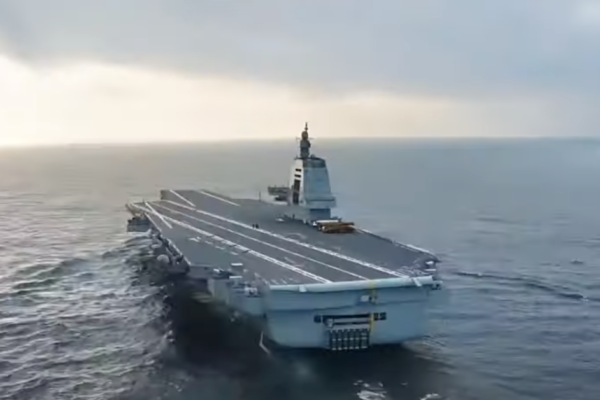Recently, the Chinese People’s Liberation Army Navy conducted the fourth sea trial of its third aircraft carrier, the “Fujian” (Fujian ship). The internal facilities of the Fujian ship, showcased for the first time, revealed the use of hard fire doors with American aircraft carrier characteristics. Experts believe that while the Fujian ship may have adopted some American design features, it may not fully comprehend the operational strategies of the United States, thus making it more of an experimental vessel. The Chinese Communist Party’s ambition to challenge the United States Navy in the Western Pacific poses significant challenges.
According to official Chinese sources, the Fujian ship departed from the Jiangnan Shipyard on September 2 for its fourth sea trial. This trial focused on the crucial testing of the electromagnetic catapult system. Photos on social media showed the Fujian ship setting sail with full-scale models of J-15 catapult fighter jets and KJ-600 airborne early warning aircraft on the flight deck.
The internal design of the Fujian ship, being the third domestically-built aircraft carrier of the Chinese Communist Party, was revealed for the first time. A military promotional video named “Tempering” demonstrated that while previous Chinese aircraft carriers adopted soft-type fire curtain doors following the Soviet technology route, the Fujian ship opted for hard fire doors more resembling American aircraft carriers.
Fire doors on aircraft carriers are essential equipment for controlling fire zones prone to ignition during combat. Pro-Beijing media mentioned that this design emphasizes isolation and explosion-proof functions, significantly enhancing the safety of the aircraft carrier.
Shu Xiaohuang, Deputy Researcher at the Institute of Chinese Political-Military and Operational Concepts at the Taiwan Institute of National Defense and Security Studies, stated that China now has its own experience in aircraft carrier construction and has dedicated time to electromagnetic catapults with relevant research and arguments. However, Western countries have been developing aircraft carriers since World War II, particularly the United States with the earliest designs of supercarriers. China’s development of large aircraft carriers naturally follows the American path.
Nevertheless, China also faces its limitations. Shu Xiaohuang noted, “It uses only three electromagnetic catapults because the Fujian is not nuclear-powered; it runs on traditional power, burning fuel. Electromagnetic catapults consume a significant amount of electricity, and during combat, a large number of high-intensity aircraft takeoffs and catapults might require massive electricity and fuel consumption. I believe the use of only three catapults on this ship is a compromise between its combat capabilities and power limitations.”
Regarding the Fujian ship’s adoption of hard fire doors with American aircraft carrier characteristics, Shu Xiaohuang expressed that besides fire doors, many other details likely incorporate American designs. The operational strategies of the Americans are specific, and the Fujian ship may not fully grasp all of them.
He explained that the American design includes four catapults to ensure simultaneous takeoff and landing operations on large aircraft carriers. However, issues like one catapult getting stuck on the angled landing deck and the arrestor wire of another jamming the forward lift could hinder the Fujian’s ability to maintain a high operational angle.
Shu Xiaohuang mentioned that while the Fujian ship may be verifying its electromagnetic catapult systems, it is still far from being combat-ready. Both the J-15 catapult aircraft and the aircraft carrier’s fifth-generation fighter, the J-35, are still undergoing intensive testing. “Building a beautiful and powerful ship is not enough; the effectiveness of its aviation squadron is crucial for its combat capabilities to be realized.”
He believes that the Fujian ship is still an experimental aircraft carrier, despite significant progress, and it will take some time before its combat capabilities are fully realized. In contrast, the U.S. military has shifted its operational mode, focusing on all-domain warfare for the past 20 years. China’s ambition to use its aircraft carrier strike group to confront the U.S. Navy in the Western Pacific presents considerable challenges.
Senior military commentator Shen Zhou stated that the Fujian carrier marks China’s shift from mimicking Russian carriers to overtly emulating American carriers. While attempting to replicate American carrier structures as much as possible, there are still many aspects that China has not fully grasped and are still in the exploration phase.
“Liaoning and Shandong mimicked the Russian Kuznetsov-class carrier, which was not designed for long-distance operations but rather sought to extend the air defense line closer to the shore using carrier-based aircraft. However, the Su-33 carrier-based aircraft designed by the Soviet Union for this purpose failed in practice. Russia abandoned the Su-33 for the Mig-29 in its inherited carriers, but these are outdated models. Russia also provided India with carriers using Mig-29 aircraft. China insisted on continuing to mimic the Su-33, creating the J-15, resulting in both the aircraft carrier and the carrier-based aircraft being unable to confront the U.S. military, significantly lacking in combat power.”
Shen Zhou emphasized that China’s carrier development has been a circuitous path, as it first copied Russia and then turned to copy the U.S. military again. However, China has not managed to steal nuclear power systems or fully understand steam catapult systems. Although they claim to have developed electromagnetic catapults, it remains unclear if they have tested launching and recovering aircraft using this system similarly to the U.S. military.
He mentioned that while U.S. aircraft carriers weigh around 100,000 tons, the Fujian carrier is about 80,000 tons, making it impossible to replicate every detail. Structural adjustments are necessary, but China aims to imitate as closely as possible. China’s carrier development journey is essentially a restart, leaning towards the U.S. military. Just like the process of copying Russian destroyers and then the American Aegis-class, the appearance and some structures may be similar, but the actual performance and combat capabilities are incomparable.

